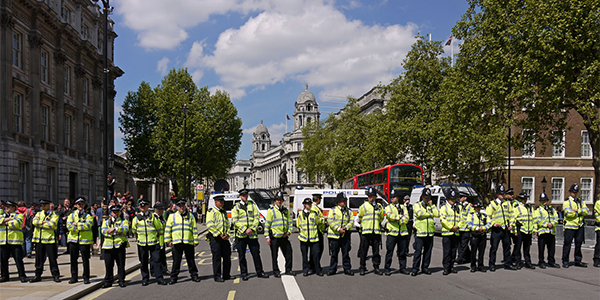Local policy responses to anti-Islamic protest in the UK need to consider both exclusionary and inclusionary approaches
Disruptive and antagonistic anti-Islamic protests in some towns and cities in the UK have posed a challenge to local authorities in how to respond to them. William Allchorn examines the variety of policy responses that have been attempted and suggests that inclusionary tactics that address narratives of polarisation need to be part of the democratic response.

Police at an EDL march and counter demonstration, 2013. Picture: Alan Denney, via a CC BY-NC-SA 2.0 licence
Over the past ten years, the UK has seen significant shifts on the far right. As the prospect of parliamentary representation by the neo-fascist British National Party petered out in 2010, a new wave of anti-Islamic protests and direct action initiatives swept the country. Over the same period, we have seen the rise and fall of UKIP – once a fringe outfit designed to pressure the Conservative party into harder Euroscepticism, its call for the UK to leave the EU has become a political reality, with its focus now seeming to converge on more radicalised forms of anti-Islam protests. Finally, there has also been a worrying rise in the number of far-right terror attacks – with the murder of MP Jo Cox by Thomas Mair in June 2016 and Darren Osborne’s attack on a mosque in Finsbury Park in June 2017 joined by several far-right terror plots that haven’t made the headlines.
With this far-right shift, one of the serious tasks now facing us as democrats is how do we respond to this new ‘normal’ of far-right politics? How do we ‘tolerate the intolerant’ within our liberal democracy? And, more pertinently, how can politicians, the police and behind-the-scenes policy-makers respond to far-right actors when they come knocking at the door of a specific town or city?
Recently published, my book – which tracks anti-Islamic protest in five UK towns and cities – tries to shed light on some of these questions. One of the first comprehensive surveys of far-right counter tactics in the UK, it looks at how mainstream politicians have tried to deal with demonstrations by the EDL and Britain First over the past ten years. Taking up specific case studies in Birmingham, Bradford, Luton, Leicester and Tower Hamlets, it finds that local politicians have been successfully engaging in (mainly exclusionary) counter tactics in order to curtail the divisive and disorderly aspects of these protests. In Luton, for instance, following a high-profile demonstration by the EDL in 2011 the town enacted a new town-centre policy so they could move far-right protest outside of the city centre – and thus reduce disorder – on subsequent occasions. When Britain First came to demonstrate four years later in the town, the local police force applied for a civil injunction to curtail the march route and restrict what material could be displayed at the demonstration event.
What has been interesting, however, is the diversity of tactics apart from the more exclusionary, ‘you’re not welcome here’ response. In Leicester, for example, after an extremely disruptive EDL demonstration in October 2010, the elected mayor granted permission for a march instead of a static demonstration, which had previously caused disorder and disruption. Moreover, in Birmingham, inclusive and consensual tactics were used to similar effect. After high-level disruption between the Muslim community and EDL demonstrators in 2009, a lower-level policing response was enacted at subsequent demonstrations – resulting in marked decreases in arrests and disorder. In this respect, then, what can be recommended is that a move away from confrontational policing tactics demonstrated an appreciable decrease in arrests and disorder when these groups come to protest.
Turning to political responses, there have been a wide array of tactics and response rationales among local politicians to far-right protest. While most tend to call for march bans and sign petitions against these protests, there have been some experiments with inclusionary tactics which try to get to grips with the drivers of anti-Islamic extremism and far-right politics. In Bradford, for example, the former head of the council David Green visited local communities with high levels of BNP voters to liaise with them and listen to their concerns. In Keighley, former MP Kris Hopkins went to meet local Muslim communities before and after demonstrations in order to reassure those anxious about the effects of the demonstrations. Such engagement with disaffected voters – and those communities affected by anti-Islamic protest – show a possible way forward in countering extremist narratives at the societal level.
Another aspect of the book is a deep dive into some of the drivers of anti-Islamic protest over the past ten years. Some of the key contextual factors in areas that have seen protests by the EDL and Britain First have included deprivation, a previous history of mass disorder events and the presence or absence of right-wing and Islamist extremism within a particular locale. In Luton, for example, there existed a visible extreme Islamist activist scene whose anti-war protests were the catalyst for the EDL in March 2009. Another item of particular concern was the levels of social polarisation in some of the communities under study that are key in the process of far-right ‘othering’. In Bradford and Luton, for example, perceptions around a lack of social mixing between different racial and religious communities has given rise to a media and policy narrative of ‘separate lives’. One particular challenge for local elites over the past ten years has therefore been to expose local folklores or rumours that are fanned when groups like the EDL and Britain First come to town. In Tower Hamlets, for example, it has been the normalisation of the narrative around ‘no-go zones’ and Islamist extremism, whilst in Leicester it was suggestions that the EDL were planning to attack a mosque that needed to be addressed when far-right mobilisations became apparent.
To conclude, the key argument of the book is that an ‘inclusionary turn’ is needed when dealing with anti-Islamic protest. Building on Ami Pedahzur’s (2004) notion of an ‘immunised’ democracy, this subscribes to the notion that better cross-community contact, grassroots educational initiatives against prejudice and a re-engagement between politicians and disaffected voters are all key preventative methods when addressing some of the underlying causes of far-right extremism. While not a ‘golden bullet’, such basic everyday measures are needed in order to stave off the prejudicial and populist barbs of groups like the EDL and Britain First in the years and months to come. As democrats, only then can we say that we’ve truly respond to the new far-right ‘normal’ in our midst.
This article gives the views of the author, and not the position of Democratic Audit. It draws on his recent book, Anti-Islamic Protest in the UK: Policy Poly Responses to the Far Right.
About the author
 Dr William Allchorn is a Postdoctoral Researcher at the University of Leeds and Associate Director at the Centre for the Analysis of the Radical Right. He is an expert on anti-Islamic radical right social movements in the UK and Western Europe. His book, Anti-Islamic Protest in the UK: Policy Responses to the Far Right, is out now with Routledge.
Dr William Allchorn is a Postdoctoral Researcher at the University of Leeds and Associate Director at the Centre for the Analysis of the Radical Right. He is an expert on anti-Islamic radical right social movements in the UK and Western Europe. His book, Anti-Islamic Protest in the UK: Policy Responses to the Far Right, is out now with Routledge.





 Democratic Audit's core funding is provided by the Joseph Rowntree Charitable Trust. Additional funding is provided by the London School of Economics.
Democratic Audit's core funding is provided by the Joseph Rowntree Charitable Trust. Additional funding is provided by the London School of Economics.